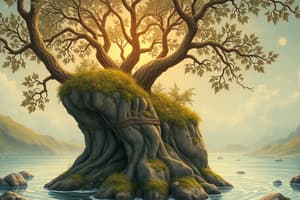Podcast
Questions and Answers
Which process involves water movement through plants and its evaporation from leaves?
Which process involves water movement through plants and its evaporation from leaves?
- Transpiration (correct)
- Infiltration
- Run-off
- Condensation
What is the term for the process in which water vapor is transformed into liquid water?
What is the term for the process in which water vapor is transformed into liquid water?
- Evaporation
- Run-off
- Sublimation
- Condensation (correct)
Which component of the hydrological cycle describes water falling to the Earth in forms like rain and snow?
Which component of the hydrological cycle describes water falling to the Earth in forms like rain and snow?
- Transpiration
- Infiltration
- Precipitation (correct)
- Evaporation
What process directly allows water in snow or glaciers to enter the atmosphere without becoming liquid first?
What process directly allows water in snow or glaciers to enter the atmosphere without becoming liquid first?
Which term describes water that moves toward streams, channels, or lakes after precipitation?
Which term describes water that moves toward streams, channels, or lakes after precipitation?
What is the main source of water for evaporation in the hydrological cycle?
What is the main source of water for evaporation in the hydrological cycle?
Which process affects the rate at which water is absorbed by soil during rainfall?
Which process affects the rate at which water is absorbed by soil during rainfall?
What does the total amount of water in the hydrological cycle do?
What does the total amount of water in the hydrological cycle do?
What is the main process by which groundwater exits the ground?
What is the main process by which groundwater exits the ground?
During the hydrological cycle, what happens to the water vapor after it condenses into clouds?
During the hydrological cycle, what happens to the water vapor after it condenses into clouds?
How does vegetation contribute to the hydrological cycle?
How does vegetation contribute to the hydrological cycle?
What is the process called when water moves from the surface to the ground, enhancing moisture content?
What is the process called when water moves from the surface to the ground, enhancing moisture content?
What ultimately happens to the water that flows as runoff?
What ultimately happens to the water that flows as runoff?
Which factor primarily drives the initial phase of the hydrological cycle?
Which factor primarily drives the initial phase of the hydrological cycle?
What is depression storage in the hydrological cycle?
What is depression storage in the hydrological cycle?
Which of the following statements about groundwater is correct?
Which of the following statements about groundwater is correct?
Flashcards are hidden until you start studying
Study Notes
The Hydrological Cycle
- The Hydrological cycle (also known as the global water cycle or the H2O cycle) describes the storage and movement of water between Earth's spheres:
- biosphere
- atmosphere
- lithosphere
- hydrosphere
- The amount of water on Earth remains constant, but its distribution changes between three forms:
- Liquid (water)
- Solid (ice)
- Gas (water vapor)
Components of the Hydrological Cycle
- Evaporation: Surface water absorbs solar radiation energy and transforms into water vapor. Oceans contribute most to this process.
- Transpiration: Plants absorb water and release it as vapor through leaves, stems, and flowers. Transpiration combines with evaporation to form evapotranspiration.
- Sublimation: Water directly transitions from a solid (ice or snow) into a gaseous (water vapor) state, bypassing the liquid form.
- Condensation: As water vapor rises and cools, it changes into liquid water droplets. These droplets form on dust particles in the air.
- Precipitation: Water falls to Earth from clouds in various forms like rain, snow, and hail. Air currents move clouds and influence precipitation patterns.
- Runoff: A portion of precipitation flows over the land's surface, moving towards rivers, lakes, or oceans as surface or sub-surface flow. Runoff occurs when precipitation exceeds soil infiltration rates.
- Infiltration: Water soaks into the soil, percolating downwards. Porosity and pore size distribution affect the infiltration rate. Infiltrated water contributes to groundwater.
- Groundwater Discharge: Water held in cracks and spaces below the ground, known as groundwater, can be tapped by wells or flow towards the surface. This process of groundwater exiting the ground is called groundwater discharge.
Processes and Pathways of the Hydrological Cycle
- The cycle begins with oceans, where water evaporates due to solar radiation.
- Water vapor forms clouds and eventually condenses to precipitate as rain, hail, or snow.
- Some precipitation evaporates back into the atmosphere, while some reaches the ground.
- Ground infiltration replenishes soil moisture and raises the water table.
- Vegetation releases transpired water back to the atmosphere.
- Runoff flows over the land, eventually reaching rivers, lakes, and finally oceans.
- The process continues as cool air blowing over oceans carries water molecules, forming more water vapor and clouds that ultimately release precipitation.
Studying That Suits You
Use AI to generate personalized quizzes and flashcards to suit your learning preferences.




